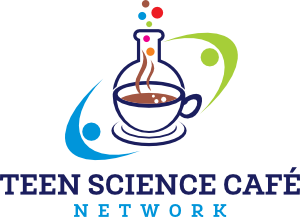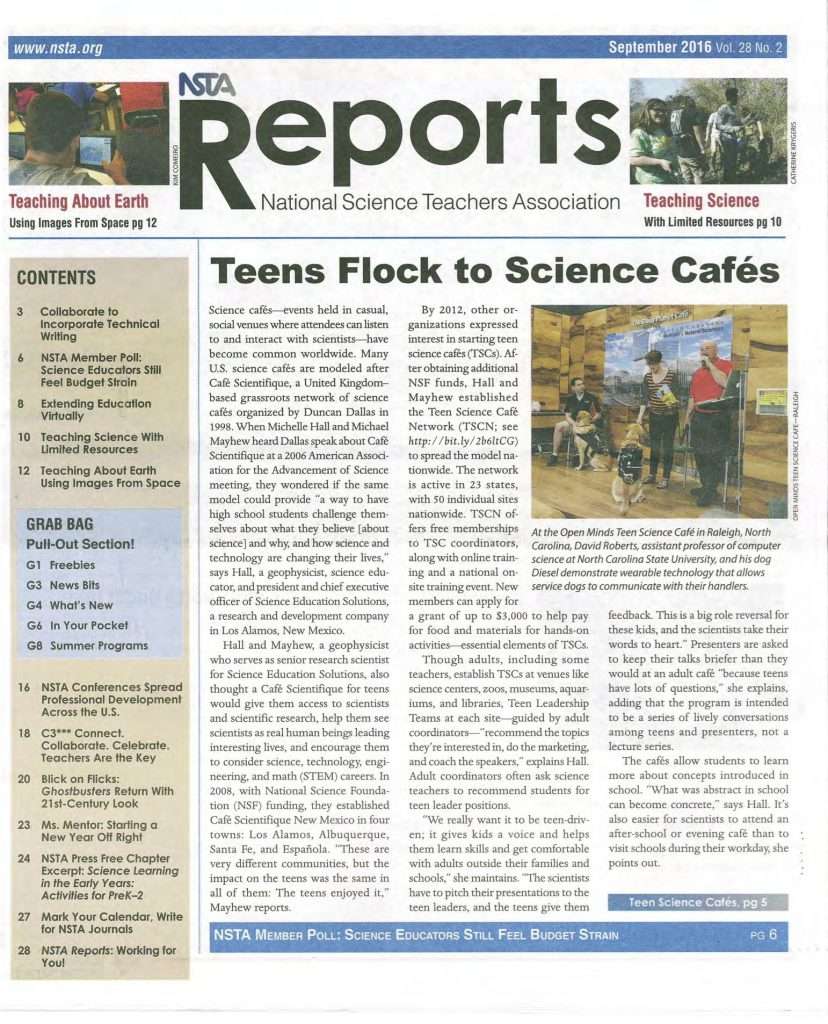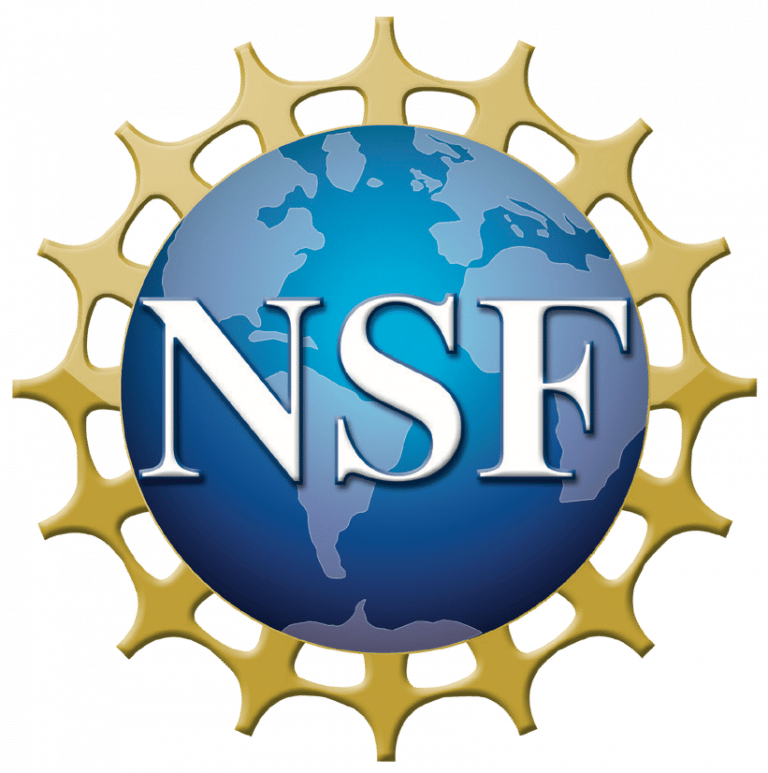Science café-events held in casual, social venues where attendees can listen to and interact with scientists—have become common worldwide. Many U.S. science cafés are modeled after Café Scientifique, a United Kingdom–based grassroots network of science cafés organized by Duncan Dallas in 1998. When Michelle Hall and Michael Mayhew heard Dallas speak about Café Scientifique at a 2006 American Association for the Advancement of Science meeting, they wondered if the same model could provide “a way to have high school students challenge themselves about what they believe [about science] and why, and how science and technology are changing their lives,” says Hall, a geophysicist, science educator, and president and chief executive officer of Science Education Solutions, a research and development company in Los Alamos, New Mexico.
Hall and Mayhew, a geophysicist who serves as senior research scientist for Science Education Solutions, also thought a Café Scientifique for teens would give them access to scientists and scientific research, help them see scientists as real human beings leading interesting lives, and encourage them to consider science, technology, engineering, and math (STEM) careers. In 2008, with National Science Foundation (NSF) funding, they established Café Scientifique New Mexico in four towns: Los Alamos, Albuquerque, Santa Fe, and Española. “These are very different communities, but the impact on the teens was the same in all of them: The teens enjoyed it,” Mayhew reports.
By 2012, other organizations expressed interest in starting teen science cafés (TSCs). After obtaining additional NSF funds, Hall and Mayhew established the Teen Science Café Network (TSCN) to spread the model nationwide. The network is active in 23 states, with 50 individual sites nationwide. TSCN offers free memberships to TSC coordinators, along with online training and a national on-site training event. New members can apply for a grant of up to $3,000 to help pay for food and materials for hands-on activities—essential elements of TSCs.
Though adults, including some teachers, establish TSCs at venues like science centers, zoos, museums, aquariums, and libraries, Teen Leadership Teams at each site—guided by adult coordinators—“recommend the topics they’re interested in, do the marketing, and coach the speakers,” explains Hall. Adult coordinators often ask science teachers to recommend students for teen leader positions.
“We really want it to be teen-driven; it gives kids a voice and helps them learn skills and get comfortable with adults outside their families and schools,” she maintains. “The scientists have to pitch their presentations to the teen leaders, and the teens give them feedback. This is a big role reversal for these kids, and the scientists take their words to heart.” Presenters are asked to keep their talks briefer than they would at an adult café “because teens have lots of questions,” she explains, adding that the program is intended to be a series of lively conversations among teens and presenters, not a lecture series.
The cafés allow students to learn more about concepts introduced in school. “What was abstract in school can become concrete,” says Hall. It’s also easier for scientists to attend an after-school or evening café than to visit schools during their workday, she points out.
“Once we get [scientists] to become adept at communicating with teens, they’re in a position to present effectively to other audiences [because] they get better at it,” Mayhew contends.
Generally, parents don’t attend TSCs because “teens might not ask questions with their parents there,” says Hall, especially when topics like the effects of alcohol and drugs are being discussed.
“And we want all kids to come, not just the ones who claim to be already interested in science. We’ve been successful in that,” observes Mayhew.
In North Carolina, Open Minds TSCs take place at the North Carolina Museum of Natural Sciences in Raleigh and at two other sites, funded by the Duke Energy Foundation. TSCs “are a way to connect teens to science careers,” says Lynn Cross, head of youth programs at the Raleigh site. “Teens can ask a presenter what he or she studied in college and what his or her workday is like.”
“Teens are typically not served in museums because it’s hard to attract them,” Kathryn Fromson, coordinator of youth programs in Raleigh, points out. “The café model is fun, relaxed, and social, and they like drop-in events [for which] you don’t have to register, just show up,” she reports.
Teens enjoy doing the hands-on activities, and “in this competitive setting, they enjoy being graded and winning prizes,” she contends.
Some teachers will give students extra credit for their participation. “We’re happy to have teachers use the café as a resource that way,” Cross observes. “We have supportive local teachers who bring their families.”
TSCs provide a way to “meet likeminded peers, people you don’t go to school with…It’s a free event that their parents approve of,” she notes.
Rockville Science Center in Rockville, Maryland, holds Young Adult Science Cafés with funding from the American Society for Biochemistry and Molecular Biology. Program coordinator Katherine Perez says, “The café started out as a place where middle school, high school, and college students could come together to discuss science events and issues…Later, we started inviting speakers, professionals in science and health who could talk to kids about careers, college, and graduate school.”
“Sometimes it’s challenging to have that wide of an age range,” she admits. “The middle school students tend to like doing the hands-on activities, but the older ones don’t…Some topics attract more of one [particular] age group; [a topic like] 3D printing is interesting to all ages.
“Many students attend the cafés as part of their grade,” she reports.
“We’d like to have more professionals in STEM fields giving talks adapted to younger kids. STEM fields can seem challenging to younger kids because there are not many mentorship opportunities, no push to join graduate programs, and many internships are unpaid…It’s hard to get jobs in STEM fields,” Perez contends.
“Presenters can serve as mentors or guide students to those who can help them,” she concludes.
The TSC at the Pacific Science Center in Seattle, Washington, “grew out of…Discovery Corps, a [teen] job training program,” says Tony Smith, program coordinator. “Discovery Corps teen members helped grow the program with guidance from adult staff.
“Our TSC Advisory Board has 20 to 25 teens,” Smith explains. One committee interviews scientists and serves as event moderators. “The food committee arranges for pizza and snacks,” he notes, while “the marketing committee does social media promotion.”
The Advisory Board created “a database of Seattle-area STEM teachers, and they e-mail fliers to them, encouraging them to give extra credit” to students who attend the cafés, says Smith. “We’ve had a very positive response from teachers.”
With speaker topics ranging from “health science to astrobiology to evolution and cooperation in species,” the events have also received high marks from teens. “‘I didn’t know this field even existed’ is what many of them say,” he reports.
This article originally appeared in the September 2016 issue of NSTA Reports, the member newspaper of the National Science Teachers Association. Each month, NSTA members receive NSTA Reports, featuring news on science education, the association, and more. Not a member? Learn how NSTA can help you become the best science teacher you can be.
The mission of NSTA is to promote excellence and innovation in science teaching and learning for all.


